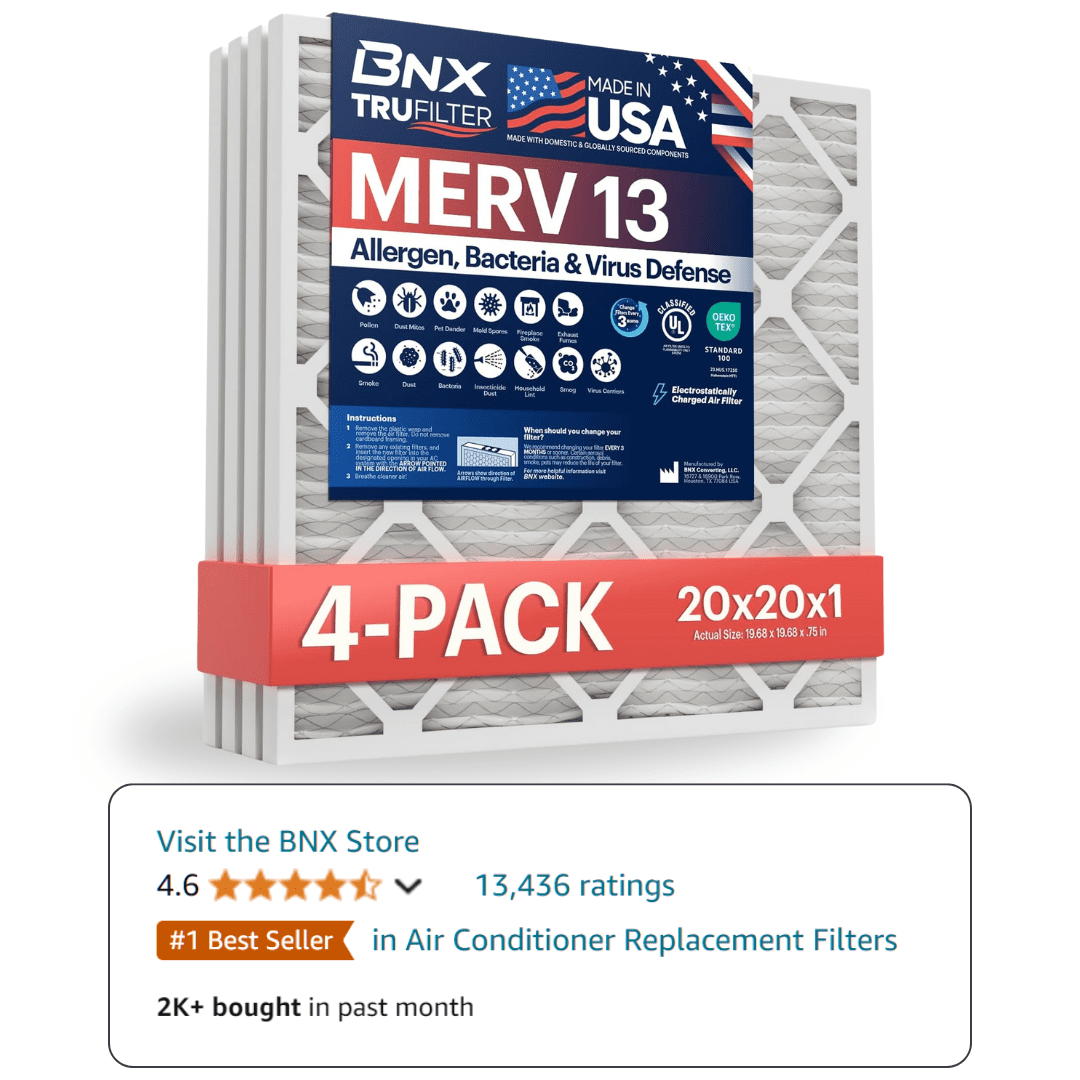Buying air filters online can be risky. Some filters might not live up to their claims, leaving you with poorer indoor air quality than you expected.
If you’ve purchased a MERV 13 filter and you’re unsure about its performance, it’s time to take matters into your own hands.
Testing the actual filtering performance of your MERV 13 filter at home can help you breathe easier, knowing your air is as clean as possible.
This guide will show you how to do just that using common tools like the Airthings View Plus, and other methods to verify your filter’s effectiveness.
What Is a MERV 13 Filter—and Why Does Actual Performance Matter?
MERV stands for Minimum Efficiency Reporting Value. It rates the effectiveness of air filters based on their ability to capture particles of different sizes.
MERV 13 filters are designed to capture small particles like dust, pollen, and some bacteria, making them ideal for people with allergies or respiratory issues.
The actual performance of a MERV 13 filter matters because if it doesn’t perform as advertised, you could be breathing in more pollutants than you think.
For example, a MERV 13 filter that’s only performing at a MERV 8 level will not catch as many small particles, potentially worsening air quality.
Quality control lapses can happen with some brands, especially with filters bought online. That’s why it’s crucial to verify your filter’s performance to ensure you’re getting the air quality you paid for.
Tools & Methods to Test Your MERV 13 Filter’s Effectiveness at Home
Basic Visual Inspection (Not Sufficient, But a Good Start)
Before diving into detailed tests, start with a visual inspection of your MERV 13 filter. Check for:
- Proper construction: Are the pleats uniform and tightly packed?
- Good fit: Does the filter fit snugly in your HVAC system?
- Correct labeling: Is the MERV rating clearly marked?
While a visual inspection can’t tell you the actual performance, it can help you spot obvious issues or defects.
Using an Air Quality Monitor (Airthings View Plus or Similar)
An air quality monitor like the Airthings View Plus can help you measure the performance of your MERV 13 filter by tracking changes in particulate matter (PM2.5 and PM1). Here’s how to test your filter:
- Baseline measurement: First, run your HVAC system without any filter or with a lower-rated filter to establish a baseline reading.
- Install the MERV 13 filter: Put in the MERV 13 filter you want to test.
- Record readings: Over the next 24-48 hours, record the PM2.5 and PM1 readings at regular intervals. Keep the HVAC fan at a consistent speed and in the same location for accurate results.
- Interpret the results: A MERV 13 filter should significantly reduce PM2.5 and PM1 levels compared to the baseline. If the decrease is minimal, your filter might not be performing as expected.
DIY Airflow & Particle Test (with Incense, Dust, or Pet Dander)
For a more hands-on approach, you can create a controlled environment to test your filter’s performance. Here’s how:
- Set up the test environment: Choose a room with minimal air circulation. Seal windows and doors to prevent outside air from affecting your test.
- Create airborne particles: Safely light incense or shake a dust cloth to release particles into the air. If you have pets, their dander can also be used.
- Measure pre- and post-filter readings: Use an air quality monitor to record PM levels before and after running your HVAC system with the MERV 13 filter. Compare the results to see how effectively the filter is capturing particles.
Advanced: Comparing with a Known (Certified) Filter
For the most accurate results, compare your MERV 13 filter to a certified, high-quality filter. You can buy verified MERV 13 filters from reputable retailers or directly from manufacturers.
- Install the certified filter: Run your HVAC system with the certified filter for a baseline reading.
- Switch to the test filter: Replace the certified filter with the MERV 13 filter you want to test.
- A/B test: Compare the PM levels with both filters. If your test filter shows significantly higher PM readings than the certified filter, it might not be performing as advertised.
How to Interpret Your Test Results and What to Do Next
Understanding your test results is crucial. A well-performing MERV 13 filter should show a significant decrease in PM2.5 and PM1 levels compared to a MERV 8 filter or no filter at all. Here’s what to look for:
- Normal MERV 13 performance: PM2.5 and PM1 levels should drop by at least 85% from the baseline.
- Big discrepancies: If your readings are only showing a 50-60% decrease, your filter might be underperforming.
If your filter isn’t meeting expectations, take action:
- Report the issue to the manufacturer and request a refund or replacement.
- Research and choose a reputable brand with third-party certifications for your next purchase.
Tips to Avoid Low-Quality MERV 13 Filters in the Future
To ensure you’re buying a reliable MERV 13 filter, look for:
- Trusted certifications: AHRI, ISO, or other reputable organizations.
- Third-party tests: Check independent reviews and performance data.
- Retailer reviews: See what other customers are saying about the filter.
- Avoid red flags: Be wary of vague labeling, missing MERV ratings, or suspiciously low prices.
FAQs About MERV Filter Testing & Air Quality Monitors
Will testing a filter void the warranty?
Most manufacturers won’t void your warranty for testing, but always check the warranty terms to be sure.
How often should you test filters?
Testing every 3-6 months is a good practice, especially if you have allergies or live in a high-pollution area.
Can Airthings View Plus replace lab testing?
While Airthings View Plus is a great tool for home testing, professional lab testing can provide more detailed and precise results.
What if PM readings are inconsistent?
Inconsistent readings can be due to changing air quality conditions. Try testing over a longer period to get a more accurate average.
Empowering You to Test Your MERV 13 Filter
Testing your MERV 13 filter at home is crucial for ensuring the air you breathe is as clean as possible. By following the steps outlined in this guide, you can confidently verify your filter’s performance and take action if it’s not meeting your expectations. Remember, your health and comfort are worth the effort.
We’d love to hear about your testing experiences or any issues you’ve encountered. Share your results in the comments below and help others make informed decisions about their air quality. For more guidance, check out our articles on:



